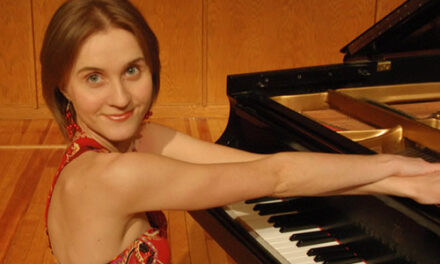Having previously reviewed the nine Conducting Fellows who performed on the EMF student orchestra concerts, I need to catch up on the other works, a pair of concertos and a pair of symphonic pieces that fall loosely into the category of “program music,” music that attempts to describe a non-musical subject or topic. I propose to approach this evening by evening, starting with the Thursday concert, conducted by José-Luis Novo and featuring the excellent violinist and Eastern Music Festival faculty member, Fabián López as soloist in Maurice Ravel’s Tzigane.
Originally written to be accompanied by the piano luthéal, a Belgian invention which converts the sound of a grand piano into a sort of lute or cimbalom, Tzigane (meaning “Gypsy”) is most often heard today with “regular” piano or in the version for orchestra that Ravel created shortly thereafter. The single movement work opens with a long cadenza for solo violin, beginning on the G string alone and then continuing in octaves over the range of the violin. López’s performance was magnificent, from the first note to the spectacular frenetic finale. He has a tone to die for, lush and rich, emanating from a superb instrument. His octaves were impeccably in tune and so sweet sounding!
After intermission, Maestro Novo masterfully led the student orchestra through a lovely performance of one of Edward Elgar’s most popular pieces (other than the perennial Pomp and Circumstance March No. 1), the Enigma Variations, a theme with 14 variations, each describing characteristics of his close circle of friends – including Dorabella, whose stutter the woodwinds imitate, Nimrod, the noble friendship of his best friend, and E.D.U., a self-portrait including his catchy four-note whistle signal. The orchestra was great, with rich strings and well-tuned winds. There were a couple of lovely viola solos played by Zaria Graves, 17, from Miami, FL.
The following evening, Friday July 14, the other student orchestra, led by Maestro Grant Cooper, also presented a concerto and a major symphonic work. The concerto features not one but four soloists and bears the title of Sinfonia Concertante in B-flat for Violin, Cello, Oboe, and Bassoon. Mozart had written a pair of sinfonias concertante a dozen years earlier, probably an outgrowth of the Baroque “concerto grosso,” of which Bach’s Brandenburg concerti are clear antecedents. This one is by Haydn.
Our soloists, among the nation’s leading practitioners of their instruments, are principal players in the EMF’s Festival Orchestra. Violin virtuoso Nigel Armstrong has recently joined the faculty and is the associate concertmaster of the Festival Orchestra. He was joined by cellist Neal Cary, oboist Randall Ellis, and bassoonist George Sakakeeny. The four soloists interacted beautifully in this charming work by the mature Haydn, written during his first London visit in 1792. The choice of instruments (two strings and two double-reeds) allows for multiple color combinations – rich, dark oboe and bassoon tones, the bright tenor of the cello, and the clear and clean high tones of the violin. Written in three movements, and structurally more like a concerto than a symphony, the work is full of musical witticisms, cadenzas, and, in the last movements, several declamatory recitatives for the solo violin, elegantly played by Armstrong. Recitatives are traditionally used to describe action in choral music, but Haydn’s use of instrumental recitative points forward to Beethoven’s use in the late quartets and famously in the last movement of the Ninth Symphony. This was a delightful performance that left the audience with smiles on their faces.
After intermission, the stage was filled with a huge orchestra for Richard Strauss’ youthful tone poem Tod und verklärung (Death and Transfiguration), a work whose scenario describes a poor and ailing man who lies dying. The listener follows the man through his suffering and occasional nostalgic memories of better days and his eventual delivery from suffering to redemption and transfiguration, in one of Strauss’ most effective musical climaxes. The orchestra played magnificently although there was a moment when the middle woodwinds appeared to have lost their concentration. Maestro Cooper seems to have a penchant for forward moving tempos that probably suit the restless nature of young musicians; the other most difficult thing to obtain from young orchestras is a long and balanced pianissimo, many examples of which were missing here. The audience signaled its approval with a quick and spontaneous ovation.











